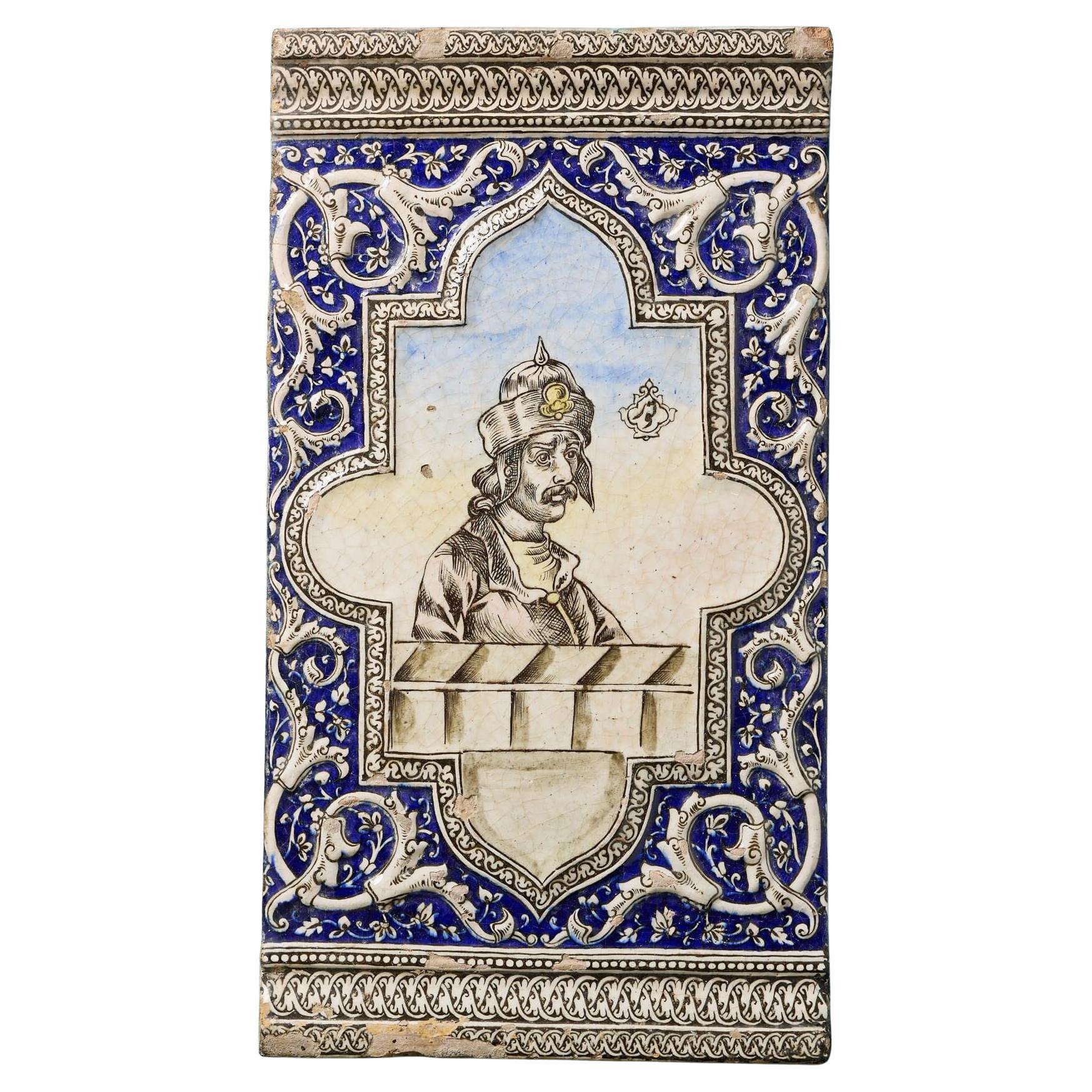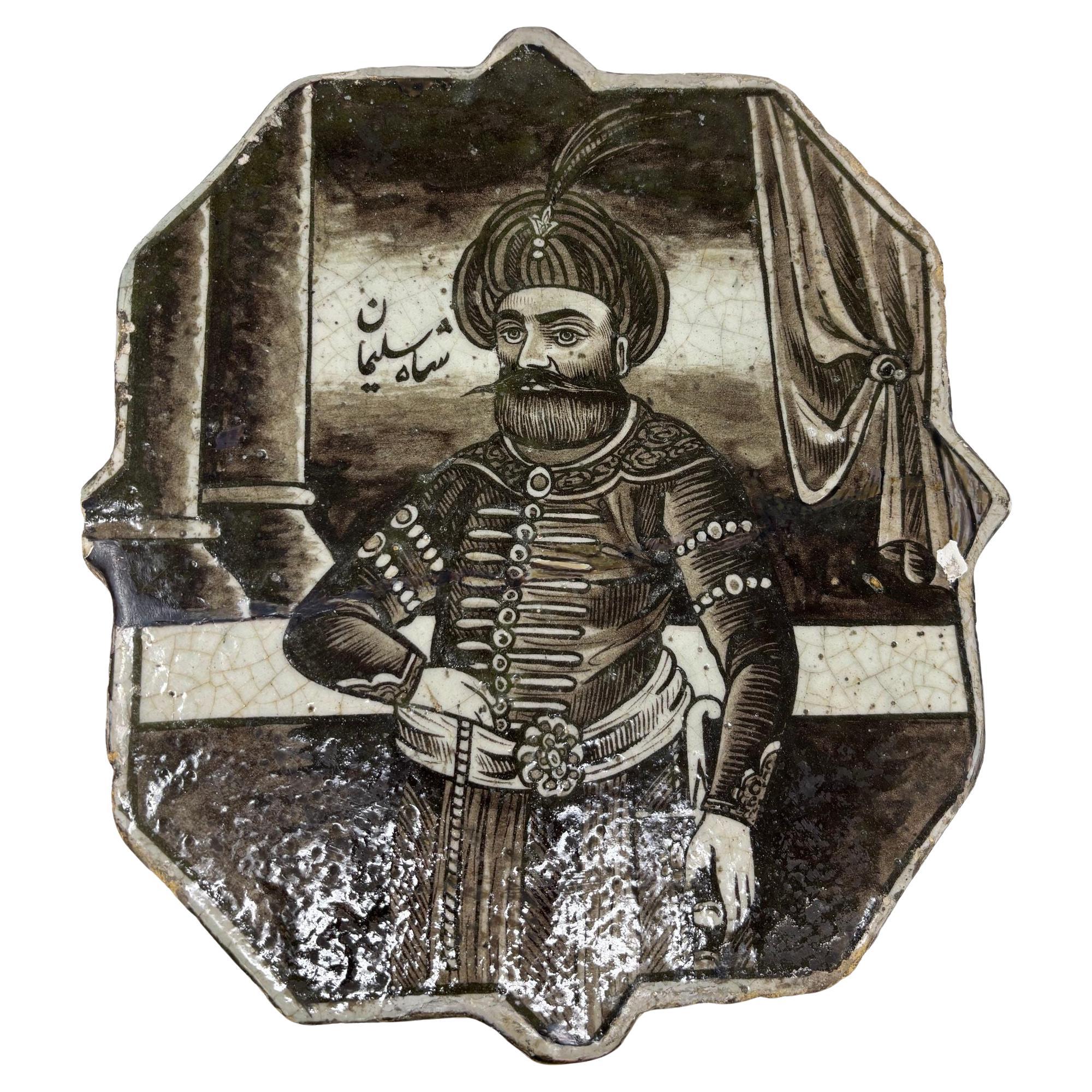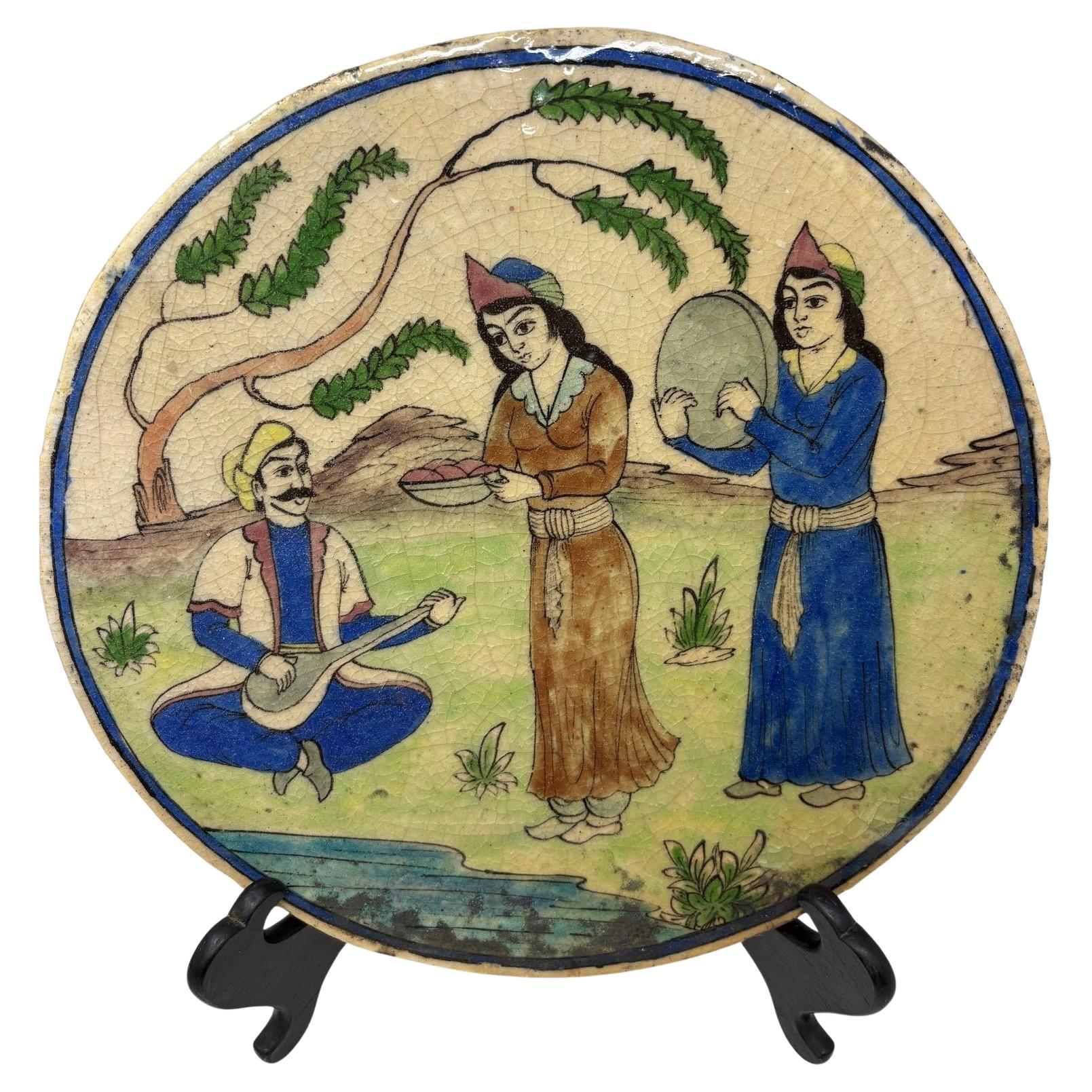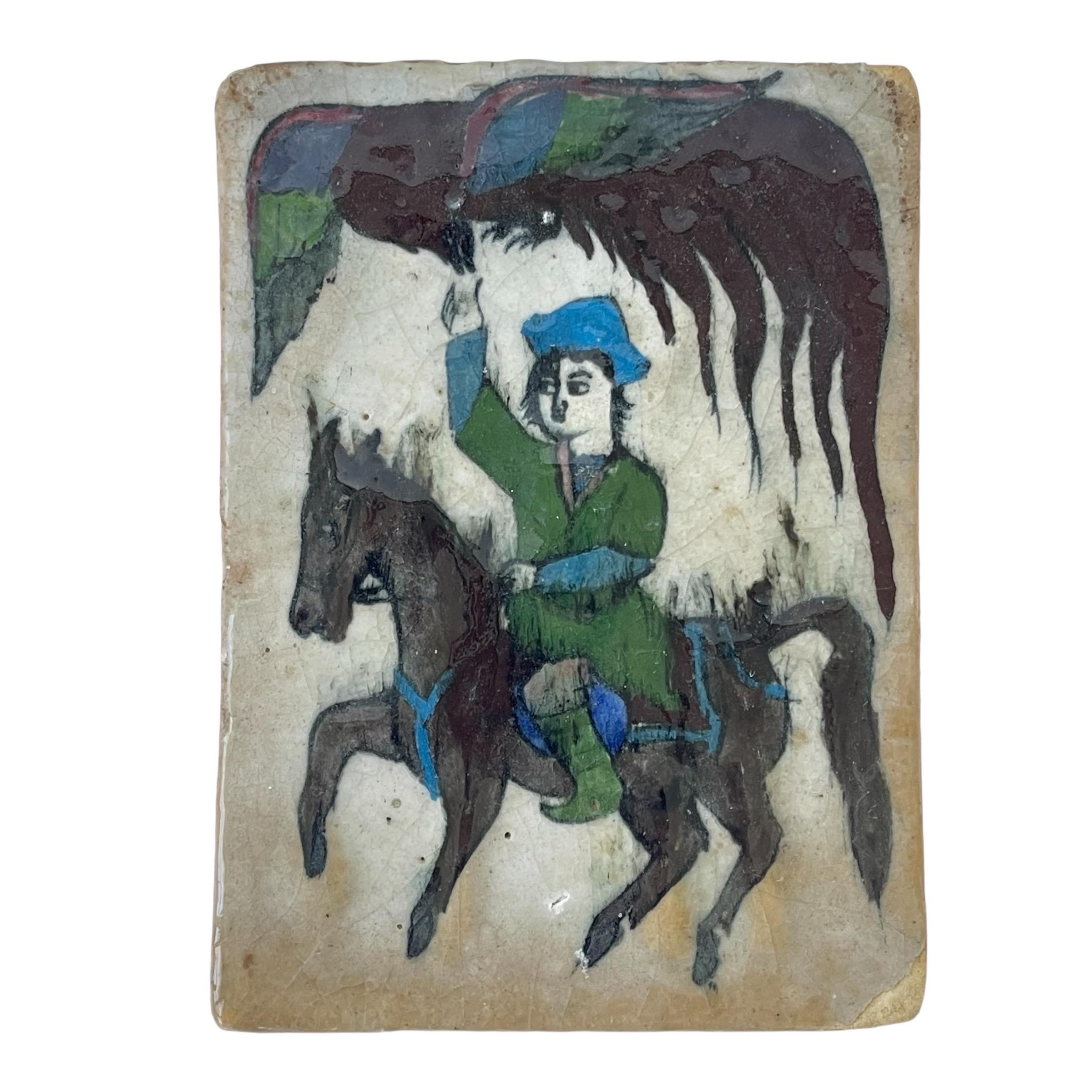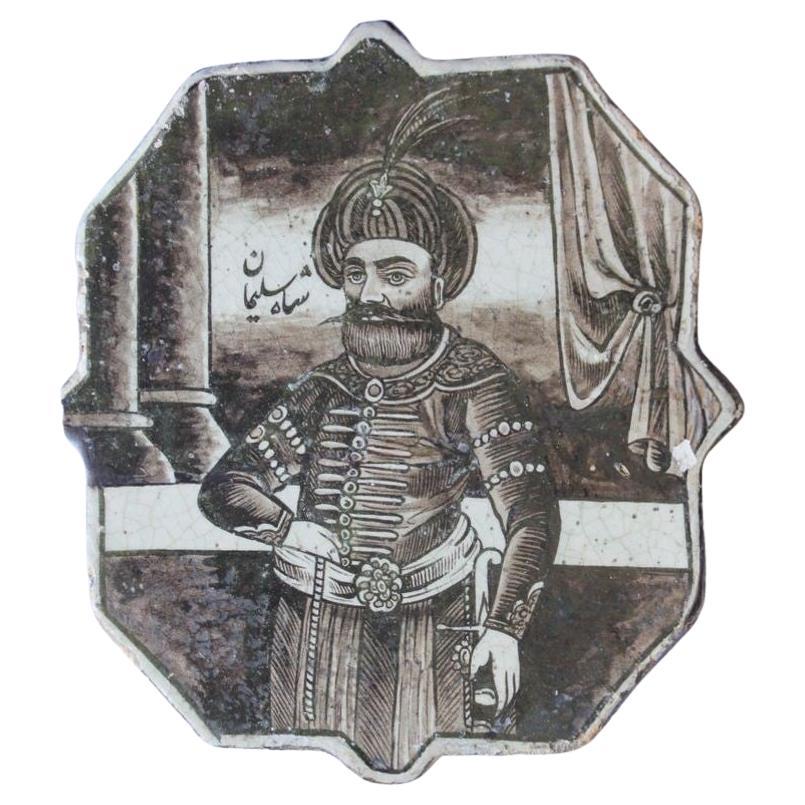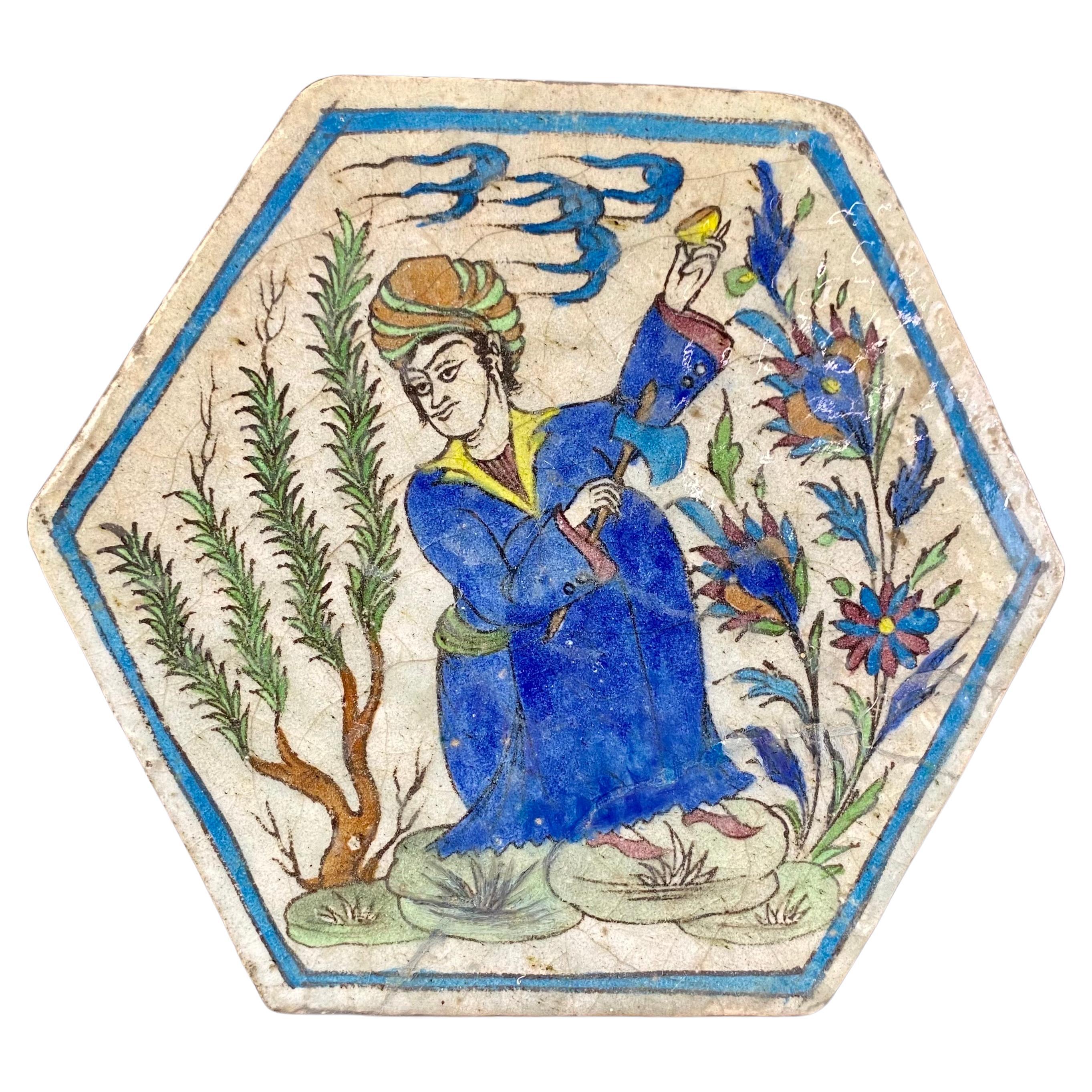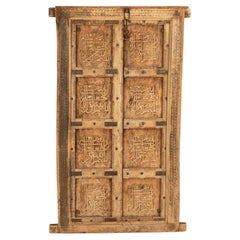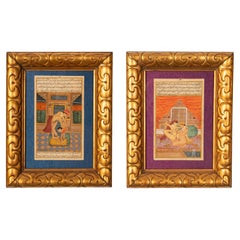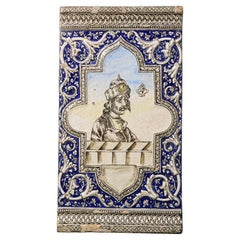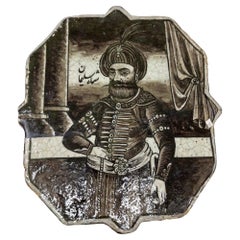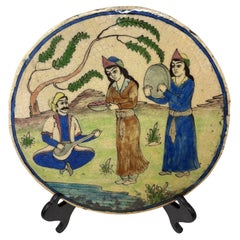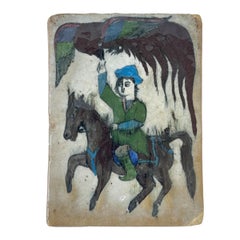Objekte ähnlich wie Antique 18th Century Persian Islamic Safavid Cuerda Seca Pottery Tile Rostam
Möchten Sie mehr Bilder oder Videos?
Zusätzliche Bilder oder Videos von dem*der Anbieter*in anfordern
1 von 13
Antique 18th Century Persian Islamic Safavid Cuerda Seca Pottery Tile Rostam
1.193,37 €
Angaben zum Objekt
Important Antique 18th Century Persian Islamic Safavid Cuerda Seca Pottery Tile depicting the legendary Persian hero Rostam, circa 1700.
The tile shows Rostam kneeling, wearing a tunic and a horned helmet, holding a scepter with deer-head finial, Rostam is kneeling under a garland festooned arch, with a falcon on a perch & a flowering urn. The background of the tile is cobalt blue with a lighter blue to the top & base, the tile is also decorated with hues of mustard, green, brown and pink. The tile is housed in a 19th century japanned wooden frame, condition is very good no damage or restoration, this rare Cuerda Seca tile is ready to hang on your wall.
Rostam or Rustam was a legendary hero in Persian mythology, the son of Zāl and Rudaba, whose life and work was immortalized by the 10th-century Persian poet Ferdowsi in the Shahnameh, or Epic of Kings, which contains pre-Islamic Iranian folklore and history. However, the roots of the narrative date much earlier.
In the Shahnameh, Rostam and his predecessors are Marzbans of Sistan (present-day Iran and Afghanistan). Rostam is best known for his tragic fight with Esfandiyār, the other legendary Iranian hero; for his expedition to Mazandaran (not to be confused with the modern Mazandaran Province). He is also known for the story of his Seven Labours.
Rostam was always represented as the mightiest of Iranian paladins (holy warriors), and the atmosphere of the episodes in which he features is strongly reminiscent of the Parthian Empire.
He rides the legendary stallion Rakhsh and wears a special suit named Babr-e Bayan in battles.
Tile size without frame 8" X 5.50"
- Maße:Höhe: 30,48 cm (12 in)Breite: 22,86 cm (9 in)Tiefe: 2,54 cm (1 in)
- Stil:Islamisch (Aus dem Zeitalter)
- Materialien und Methoden:Töpferwaren,Glasiert
- Herkunftsort:
- Zeitalter:1710–1719
- Herstellungsjahr:Circa 1700
- Zustand:Abnutzung dem Alter und der Nutzung entsprechend. Very good antique condition.
- Anbieterstandort:Portland, OR
- Referenznummer:Anbieter*in: BB-83331stDibs: LU4876145433292
Anbieterinformationen
5,0
Platin-Anbieter*in
Premium-Anbieter*innen mit einer Bewertung über 4,7 und 24 Stunden Reaktionszeit
Gründungsjahr 2000
1stDibs-Anbieter*in seit 2019
423 Verkäufe auf 1stDibs
Typische Antwortzeit: <1 Stunde
- VersandAngebot wird abgerufen …Versand von: Portland, OR
- Rückgabebedingungen
Einige Inhalte dieser Seite wurden automatisch übersetzt. Daher kann 1stDibs nicht die Richtigkeit der Übersetzungen garantieren. Englisch ist die Standardsprache dieser Website.
Authentizitätsgarantie
Im unwahrscheinlichen Fall eines Problems mit der Echtheit eines Objekts kontaktieren Sie uns bitte innerhalb von 1 Jahr für eine volle Rückerstattung. DetailsGeld-Zurück-Garantie
Wenn Ihr Objekt nicht der Beschreibung entspricht, beim Transport beschädigt wurde oder nicht ankommt, kontaktieren Sie uns bitte innerhalb von 7 Tagen für eine vollständige Rückerstattung. DetailsStornierung innerhalb von 24 Stunden
Sie können Ihren Kauf jederzeit innerhalb von 24 Stunden stornieren, ohne jegliche Gründe dafür angeben zu müssen.Geprüfte Anbieter*innen
Unsere Anbieter*innen unterliegen strengen Dienstleistungs- und Qualitätsstandards, wodurch wir die Seriosität unserer Angebote gewährleisten können.Preisgarantie
Wenn Sie feststellen, dass ein*e Anbieter*in dasselbe Objekt anderswo zu einem niedrigeren Preis anbietet, werden wir den Preis entsprechend anpassen.Zuverlässige weltweite Lieferung
Unsere erstklassigen Versandunternehmen bieten spezielle Versandoptionen weltweit, einschließlich individueller Lieferung.Mehr von diesem*dieser Anbieter*in
Alle anzeigenAntike 18. Jahrhundert islamischen osmanischen Iznik Kutayha Pottery Teller Türkei 1750
Ein guter antiker osmanischer Iznik/Kutayha-Keramikteller aus dem 18. Jahrhundert, um 1750.
Der Teller mit cremefarbenem Glasurgrund, handbemalt mit mehrfarbigen floralen Motiven in ...
Kategorie
Antik, 1750er, Türkisch, Islamisch, Tonwaren
Materialien
Töpferwaren
Antikes arabisches marokkanisches, islamisches Kalligraphie-Türfenster aus dem 19. Jahrhundert 1850
Ein gutes Paar antiker marokkanischer Hartholztüren oder Fensterläden, geschnitzt mit islamischer Kalligrafie, um 1850
Die Türen sind in ihrem ursprünglichen geschnitzten Rahmen unte...
Kategorie
Antik, 1850er, Marokkanisch, Islamisch, Türen und Tore
Materialien
Eisen
Antike 18. Jahrhundert Paar indische Hindu erotische Kamasutra Miniatur Gemälde 1750
Ein hochwertiges Paar antiker erotischer indischer Kamasutra-Gemälde aus dem 18. Jahrhundert, um 1750.
Die Gemälde, die höchstwahrscheinlich aus Nordostindien oder Nepal stammen, sin...
Kategorie
Antik, Mitte des 18. Jahrhunderts, Indisch, Anglo-indisch, Gemälde, Lein...
Materialien
Farbe
Antiker islamischer Hispano-Kerzenständer aus Moresque-Lüster-Keramik, Mamluk-Nasrid, 1870
Von The Cantagalli Workshop
Unglaublich seltener/einzigartiger & monumentaler antiker Mamluken/Nasriden-Keramik-Kupferglanz-Leuchter, um 1870.
Dieser unglaubliche Keramik-Kerzenhalter folgt der Form eines aus ...
Kategorie
Antik, 1870er, Spanisch, Islamisch, Kerzenständer
Materialien
Keramik
10.631 € Angebotspreis
30 % Rabatt
Antike Kütahya Keramik Ikone Fliese Armenische Jungfrau Maria & Child Jesus Türkei 1820
Eine bedeutende Ikonenfliese aus Kütahya aus dem 19. Jahrhundert mit der Jungfrau Maria und dem Christuskind, Türkei, um 1850.
Die Fliese wurde höchstwahrscheinlich für die christlic...
Kategorie
Antik, Frühes 19. Jahrhundert, Türkisch, Sonstiges, Tonwaren
Materialien
Töpferwaren
Antike chinesische Qing Dynasty 1644-1911 Emaille auf Kupfer Cloisonne Teller Schale
Eine feine antike chinesische Cloisonne-Schale aus der Qing-Dynastie (1644-1911), um 1880.
Die Schale ist fein verziert mit goldenen Spiralen auf schwarzem Emailgrund, in der Mitte s...
Kategorie
Antik, 1880er, Chinesisch, Qing-Dynastie, Metallarbeit
Materialien
Kupfer, Emaille
Das könnte Ihnen auch gefallen
Große persische Qajar-Keramik des 19. Jahrhunderts Islamische Fliese
Eine seltene große islamische Fliese aus persischer Qajar-Keramik aus dem 19.
In großem Maßstab gemalt mit der Darstellung eines persischen Prinzen in einer geformten Kartusche, fl...
Kategorie
Antik, Mittleres 19. Jahrhundert, Persisch, Dekorative Kunst
Materialien
Keramik
Antike islamisch- türkische osmanische Keramikfliesen aus Keramik 1880
Antike handbemalte türkische Keramikfliese aus dem 19. Jahrhundert.
Gemälde Figur eines Schahs Suleiman in einem Palast vor einer Kolonnade und einem Vorhang.
Arabische Schrift in de...
Kategorie
Antik, 19. Jahrhundert, Türkisch, Islamisch, Tonwaren
Materialien
Keramik, Töpferwaren
Antiker persischer runder Qajar-Dekofliesen aus Persien
Antike persische Qajar-nahöstliche islamische Fliesentafel 19. Jahrhundert oder früher.
Asiatische glasierte Keramikfliese im maurischen Stil, die eine Szene im Freien mit Musikern u...
Kategorie
Antik, Spätes 19. Jahrhundert, Asiatisch, Islamisch, Tonwaren
Materialien
Keramik
Antike handgefertigte persische glasierte Qajar-Tonfliese, Iran, CIRCA 1900s
Von L’atelier Arman Safavi
Antike persische Qajar-Fliese, handgefertigt aus Tonkeramik mit einer von Hand aufgetragenen Glasur, die eine Szene mit einem Falkner zu Pferd zeigt, Iran, CIRCA 1900er Jahre
Kategorie
20. Jahrhundert, Persisch, Islamisch, Architektonische Elemente
Materialien
Ton, Farbe, Keramik
Antike islamisch- türkische osmanische Keramikfliesen
Antike handbemalte türkische Keramikfliese aus dem 19. Jahrhundert.
Gemälde Figur eines Schahs Suleiman in einem Palast vor einer Kolonnade und einem Vorhang.
Arabische Schrift in de...
Kategorie
Vintage, 1920er, Türkisch, Maurisch, Tonwaren
Materialien
Keramik
Sechseckige handbemalte Steingutfliesen aus der Qadjar Kadjar-Periode – Asien
Sechseckige Kadjar-Fliese aus handbemaltem, emailliertem Steingut mit einer Figur in traditioneller blauer Kleidung mit orangefarbenem und grünem Turban, die eine Axt und ein Weihrau...
Kategorie
20. Jahrhundert, Asiatisch, Antiquitäten
Materialien
Fayence, Tonware
